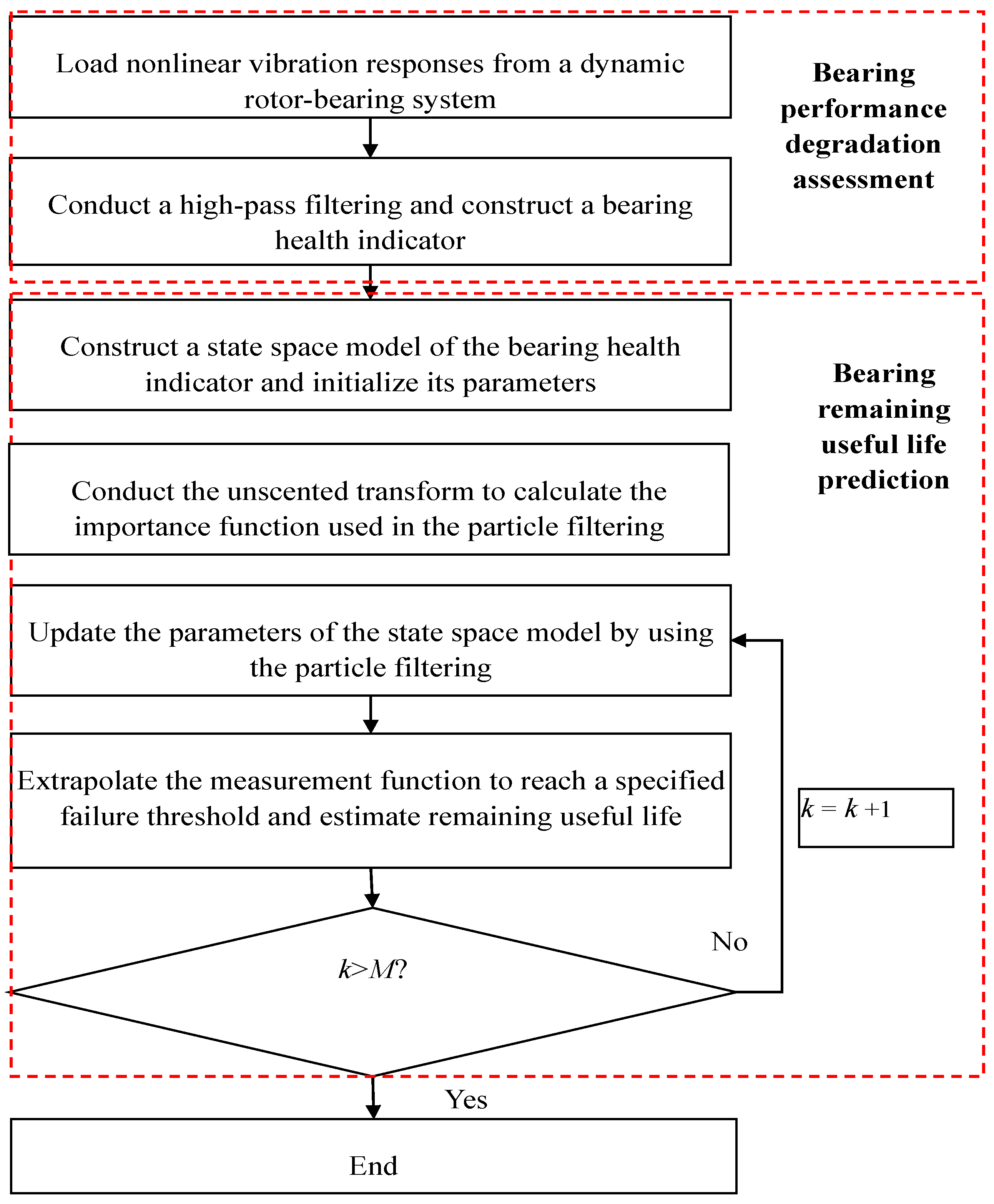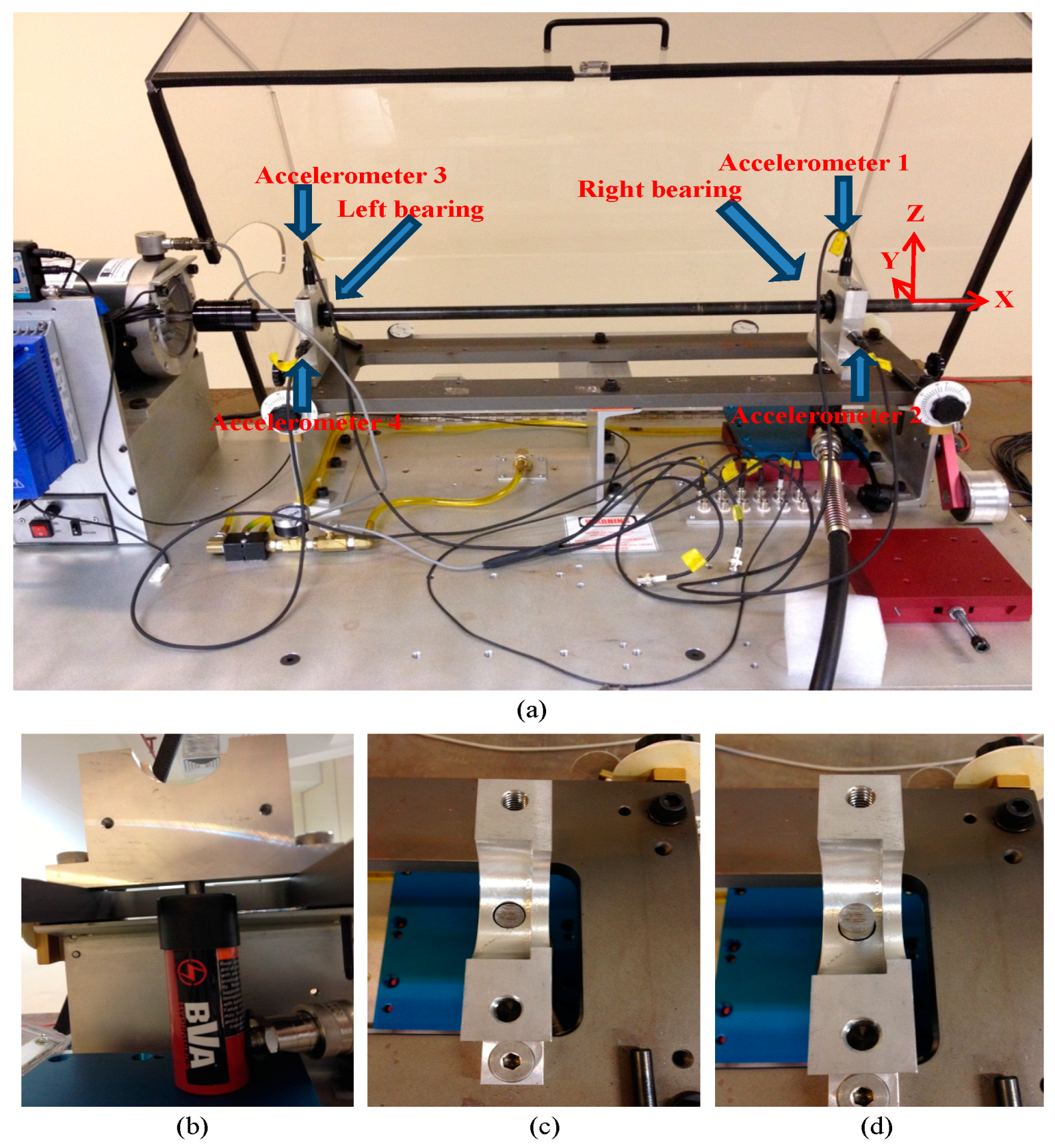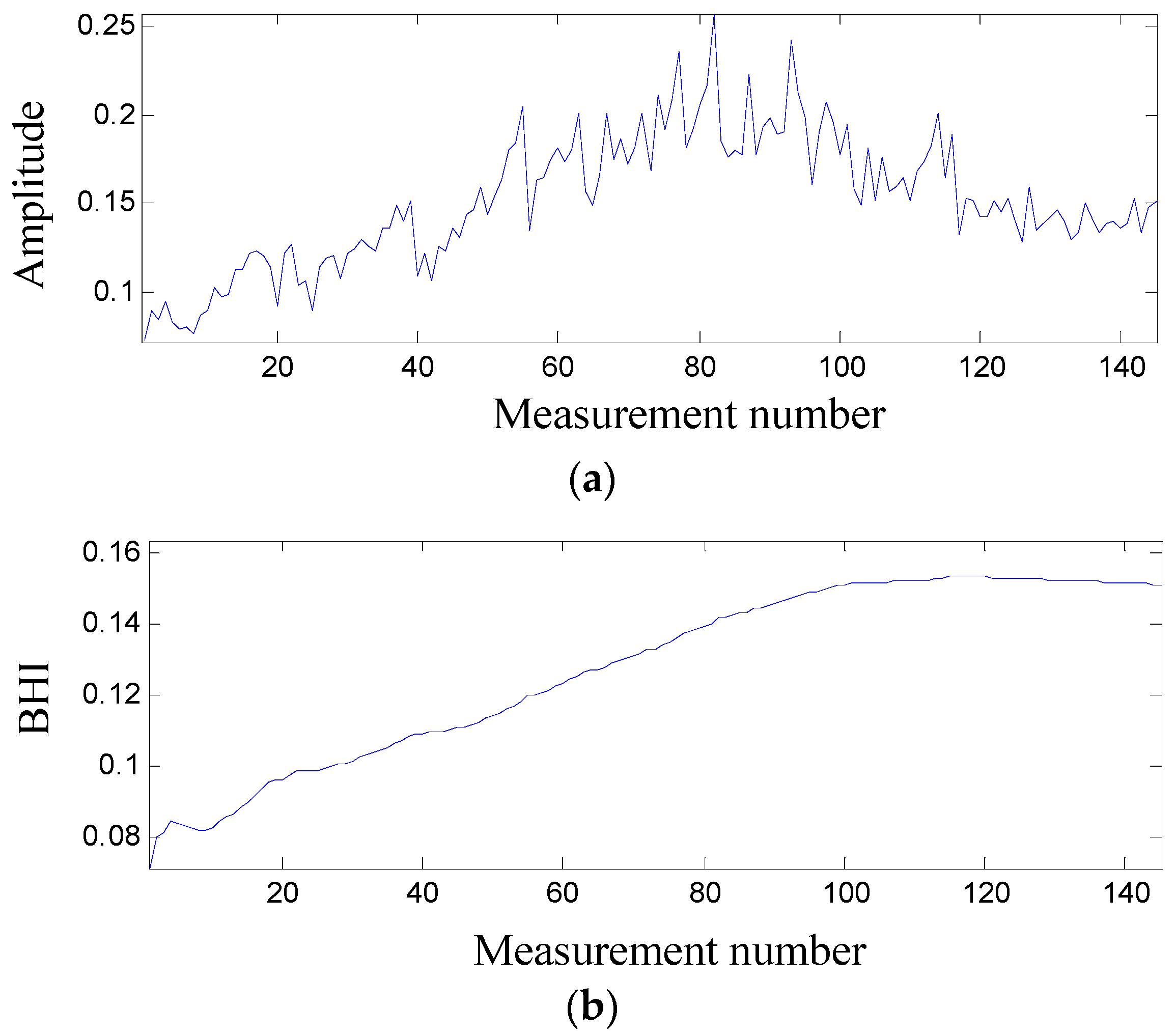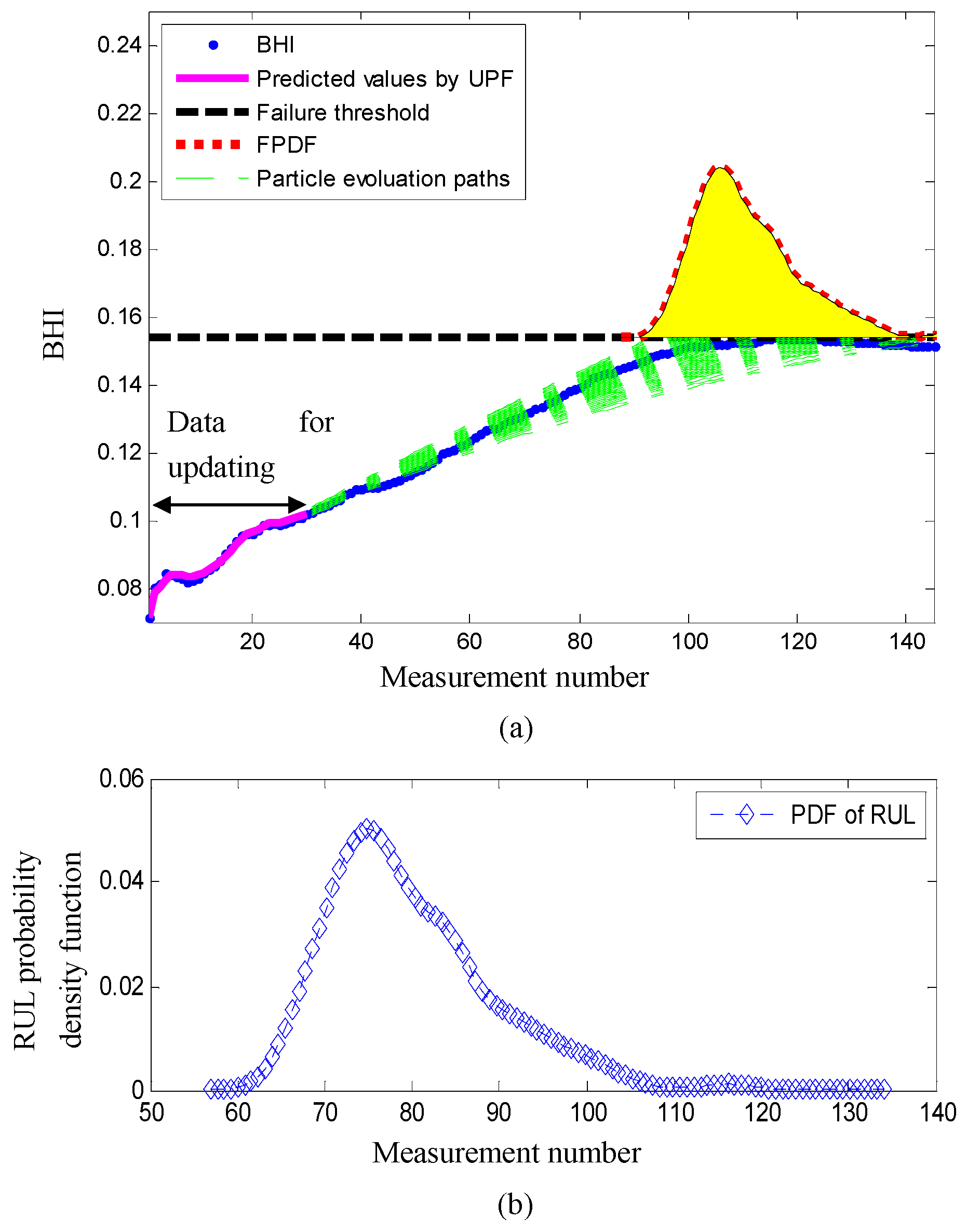State Space Formulation of Nonlinear Vibration Responses Collected from a Dynamic Rotor-Bearing System: An Extension of Bearing Diagnostics to Bearing Prognostics
Abstract
:1. Introduction
2. The Basic Theories of Unscented Particle Filtering
2.1. Particle Filtering
2.2. Unscented Transform
3. State Space Formulation of Nonlinear Vibration Responses for the Bearing Prognostics of a Dynamic Rotor-Bearing System
3.1. Bearing Performance Degradation Assessment
3.2. State Space Formulation of Bearing Performance Degradation
3.3. Posterior State Parameter Estimation of the Bearing State Space Model Using Unscented Particle Filtering
3.4. Bearing Remaining Useful Life Prediction
4. A Case Study of Bearing Prognostics
5. Conclusions
Acknowledgments
Author Contributions
Conflicts of Interest
References
- Li, C.; Sanchez, V.; Zurita, G.; Lozada, M.C.; Cabrera, D. Rolling element bearing defect detection using the generalized synchrosqueezing transform guided by time–frequency ridge enhancement. ISA Trans. 2016, 60, 274–284. [Google Scholar] [CrossRef] [PubMed]
- Tse, P.W.; Peng, Y.H.; Yam, R. Wavelet Analysis and Envelope Detection For Rolling Element Bearing Fault Diagnosis—Their Effectiveness and Flexibilities. J. Vib. Acoust. 2001, 123, 303–310. [Google Scholar] [CrossRef]
- Gao, R.X.; Yan, R. Wavelets: Theory and Applications for Manufacturing; Springer: New York, NY, USA, 2010. [Google Scholar]
- Karam, S.; Centobelli, P.; D’Addona, D.M.; Teti, R. Online prediction of cutting tool life in turning via cognitive decision making. Procedia CIRP 2016, 41, 927–932. [Google Scholar] [CrossRef]
- Randall, R.B. Vibration-Based Condition Monitoring Industrial, Aerospace and Automotive Applications; John Wiley & Sons: Chichester, UK, 2011. [Google Scholar]
- Tse, P.W.; Leung, J.C. Advanced System for Automatically Detecting Faults Occurring in Bearings, 1st ed.; Nova Science Publishers: New York, NY, USA, 2010. [Google Scholar]
- Shen, C.; He, Q.; Kong, F.; Peter, W.T. A fast and adaptive varying-scale morphological analysis method for rolling element bearing fault diagnosis. Proc. Inst. Mech. Eng. Part C J. Mech. Eng. Sci. 2013, 227, 1362–1370. [Google Scholar] [CrossRef]
- Wang, C.; Kong, F.; He, Q.; Hu, F.; Liu, F. Doppler Effect removal based on instantaneous frequency estimation and time domain re-sampling for wayside acoustic defective bearing detector system. Measurement 2014, 50, 346–355. [Google Scholar] [CrossRef]
- He, Q.; Song, H.; Ding, X. Sparse Signal Reconstruction Based on Time-Frequency Manifold for Rolling Element Bearing Fault Signature Enhancement. IEEE Trans. Instrum. Meas. 2016, 65, 482–491. [Google Scholar] [CrossRef]
- Antoni, J. Fast computation of the Kurtogram for the detection of transient faults. Mech. Syst. Signal Process. 2007, 21, 108–124. [Google Scholar] [CrossRef]
- Lei, Y.; Lin, J.; He, Z.; Zi, Y. Application of an improved Kurtogram method for fault diagnosis of rolling element bearings. Mech. Syst. Signal Process. 2011, 25, 1738–1749. [Google Scholar] [CrossRef]
- Wang, D.; Tse, P.W.; Tsui, K.L. An enhanced Kurtogram method for fault diagnosis of rolling element bearings. Mech. Syst. Signal Process. 2013, 35, 176–199. [Google Scholar] [CrossRef]
- Tse, P.W.; Wang, D. The design of a new sparsogram for fast bearing fault diagnosis: Part 1 of the two related manuscripts that have a joint title as “Two automatic vibration-based fault diagnostic methods using the novel sparsity measurement—Parts 1 and 2”. Mech. Syst. Signal Process. 2013, 40, 499–519. [Google Scholar] [CrossRef]
- Li, C.; Cabrera, D.; de Oliveira, J.V.; Sanchez, R.-V.; Cerrada, M.; Zurita, G. Extracting repetitive transients for rotating machinery diagnosis using multiscale clustered grey infogram. Mech. Syst. Signal Process. 2016, 76, 157–173. [Google Scholar] [CrossRef]
- He, W.; Jiang, Z.N.; Feng, K. Bearing fault detection based on optimal wavelet filter and sparse code shrinkage. Measurement 2009, 42, 1092–1102. [Google Scholar] [CrossRef]
- Lin, J.; Qu, L.S. Feature extraction based on Morlet wavelet and its application for mechanical fault diagnosis. J. Sound Vib. 2000, 234, 135–148. [Google Scholar] [CrossRef]
- Bozchalooi, I.S.; Liang, M. A smoothness index-guided approach to wavelet parameter selection in signal de-noising and fault detection. J. Sound Vib. 2007, 308, 246–267. [Google Scholar] [CrossRef]
- Miao, Q.; Tang, C.; Liang, W.; Pecht, M. Health Assessment of Cooling Fan Bearings Using Wavelet-Based Filtering. Sensors 2013, 13, 274–291. [Google Scholar] [CrossRef] [PubMed]
- Qiu, H.; Lee, J.; Lin, J.; Yu, G. Robust performance degradation assessment methods for enhanced rolling element bearing prognostics. Adv. Eng. Inform. 2003, 17, 127–140. [Google Scholar] [CrossRef]
- Qiu, H.; Lee, J.; Lin, J.; Yu, G. Wavelet filter-based weak signature detection method and its application on rolling element bearing prognostics. J. Sound Vib. 2006, 289, 1066–1090. [Google Scholar] [CrossRef]
- Ocak, H.; Loparo, K.A.; Discenzo, F.M. Online tracking of bearing wear using wavelet packet decomposition and probabilistic modeling: A method for bearing prognostics. J. Sound Vib. 2007, 302, 951–961. [Google Scholar] [CrossRef]
- Pan, Y.; Chen, J.; Guo, L. Robust bearing performance degradation assessment method based on improved wavelet packet–support vector data description. Mech. Syst. Signal Process. 2009, 23, 669–681. [Google Scholar] [CrossRef]
- Liao, L.; Lee, J. A novel method for machine performance degradation assessment based on fixed cycle features test. J. Sound Vib. 2009, 326, 894–908. [Google Scholar] [CrossRef]
- Ng, S.Y.; Cabrera, J.; Tse, P.T.; Chen, A.; Tsui, K. Distance-based analysis of dynamical systems reconstructed from vibrations for bearing diagnostics. Nonlinear Dyn. 2015, 80, 147–165. [Google Scholar] [CrossRef]
- Särkkä, S. Bayesian Filtering and Smoothing; Cambridge University Press: Cambridge, UK, 2013. [Google Scholar]
- Sun, J.; Zuo, H.; Wang, W.; Pecht, M.G. Application of a state space modeling technique to system prognostics based on a health index for condition-based maintenance. Mech. Syst. Signal Process. 2012, 28, 585–596. [Google Scholar] [CrossRef]
- He, W.; Williard, N.; Osterman, M.; Pecht, M. Prognostics of lithium-ion batteries based on Dempster–Shafer theory and the Bayesian Monte Carlo method. J. Power Sources 2011, 196, 10314–10321. [Google Scholar] [CrossRef]
- Van der Merwe, R.; Doucet, A.; de Freitas, N.; Wan, E. The Unscented Particle Filter; NIPS: Grenada, Spain, 2000; pp. 584–590. [Google Scholar]
- Arulampalam, M.S.; Maskell, S.; Gordon, N.; Clapp, T. A tutorial on particle filters for online nonlinear/non-Gaussian Bayesian tracking. IEEE Trans. Signal. Process. 2002, 50, 174–188. [Google Scholar] [CrossRef]
- Doucet, A.; Johansen, A.M. A tutorial on particle filtering and smoothing: Fifteen years later. In Handbook of Nonlinear Filtering; Cambridge University Press: Cambridge, UK, 2009. [Google Scholar]
- De Lacalle, L.N.L.; Lamikiz, A.; Sánchez, J.A.; de Bustos, I.F. Simultaneous measurement of forces and machine tool position for diagnostic of machining tests. IEEE Trans. Instrum. Meas. 2005, 54, 2329–2335. [Google Scholar]
- De Lacalle, L.N.L.; Lamikiz, A.; Sánchez, J.A.; de Bustos, I.F. Recording of real cutting forces along the milling of complex parts. Mechatronics 2006, 16, 21–32. [Google Scholar] [CrossRef]






| Specifications of Bearings | Parameters |
|---|---|
| Bearing model | MB ER-12K |
| Number of rolling elements | 8 |
| Rolling element diameter | 7.9375 mm |
| Pitch diameter | 33.4772 mm |
| Contact angle | 0° |
| Fundamental train frequency (FTF) | 11.3 Hz |
| Ball pass frequency outer (BPFO) | 91.4 Hz |
| Ball pass frequency inner (BPFI) | 148.5 Hz |
| Ball spin frequency (BSF) | 59.8 Hz |
| Prediction at File Number | 5th Percentile of Predicted RUL | 50th Percentile of Predicted RUL | 95th Percentile of Predicted RUL | Actual RUL | Error between Actual RUL and 50th Percentile of Predicted RUL |
|---|---|---|---|---|---|
| 20 | 67 | 73 | 83 | 96 | 23 |
| 30 | 68 | 78 | 95.5 | 86 | 8 |
| 40 | 58 | 69 | 90 | 76 | 7 |
| 50 | 56 | 64 | 95 | 66 | 2 |
| 60 | 38 | 47 | 71 | 56 | 9 |
| 70 | 25 | 28 | 33 | 46 | 8 |
| 80 | 29 | 30 | 32 | 36 | 6 |
| 90 | 19 | 24 | 37 | 26 | 2 |
| 100 | 10 | 14 | 20 | 16 | 2 |
| 110 | 2 | 3 | 4 | 6 | 3 |
| Prediction at File Number | 5th Percentile of Predicted RUL | 50th Percentile of Predicted RUL | 95th Percentile of Predicted RUL | Actual RUL | Error between Actual RUL and 50th Percentile of Predicted RUL |
|---|---|---|---|---|---|
| 20 | 66 | 73 | 85 | 96 | 23 |
| 30 | 65 | 76 | 100 | 86 | 10 |
| 40 | 51 | 61 | 82 | 76 | 15 |
| 50 | 52 | 63 | 89 | 66 | 3 |
| 60 | 37 | 46 | 69 | 56 | 10 |
| 70 | 31 | 37 | 58 | 46 | 9 |
| 80 | 19 | 25 | 35 | 36 | 11 |
| 90 | 11 | 15 | 22 | 26 | 11 |
| 100 | 5 | 8 | 16 | 16 | 8 |
| 110 | 2 | 3 | 7 | 6 | 3 |
© 2017 by the authors. Licensee MDPI, Basel, Switzerland. This article is an open access article distributed under the terms and conditions of the Creative Commons Attribution (CC BY) license ( http://creativecommons.org/licenses/by/4.0/).
Share and Cite
Tse, P.W.; Wang, D. State Space Formulation of Nonlinear Vibration Responses Collected from a Dynamic Rotor-Bearing System: An Extension of Bearing Diagnostics to Bearing Prognostics. Sensors 2017, 17, 369. https://doi.org/10.3390/s17020369
Tse PW, Wang D. State Space Formulation of Nonlinear Vibration Responses Collected from a Dynamic Rotor-Bearing System: An Extension of Bearing Diagnostics to Bearing Prognostics. Sensors. 2017; 17(2):369. https://doi.org/10.3390/s17020369
Chicago/Turabian StyleTse, Peter W., and Dong Wang. 2017. "State Space Formulation of Nonlinear Vibration Responses Collected from a Dynamic Rotor-Bearing System: An Extension of Bearing Diagnostics to Bearing Prognostics" Sensors 17, no. 2: 369. https://doi.org/10.3390/s17020369







